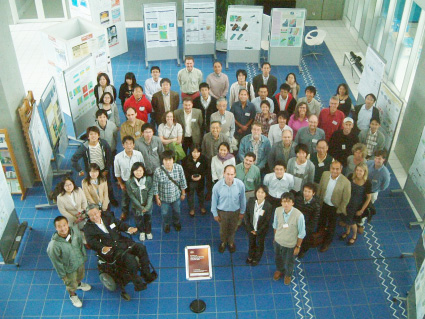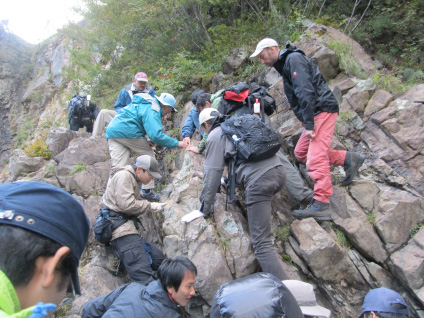
Workshop on “Ocean Mantle Dynamics: From Spreading Center to Subduction Zone” Held in Chiba, Japan
Nobukazu Seama, Dept of Earth & Planetary Sciences, Kobe University, Kobe, Japan
Douglas Wiens, Dept of Earth & Planetary Sciences, Washington University, Saint Louis, MO, USA
Kyoko Okino, Atmosphere and Ocean Research Center (AORI), University of Tokyo, Kashiwa, Chiba, Japan
77 Scientists from six different countries gathered at AORI in Chiba, Japan on October 4-6, 2011 to discuss recent developments in the study of the dynamics of the oceanic lithosphere, melt production at oceanic spreading centers and islands arcs, and associated topics. The meeting was supported by several organizations, including the Japanese TAIGA project, the US Geoprisms program, AORI and the Ocean Alliance of University of Tokyo, as well as InterRidge. The scientific organizing committee consisted of the members of the InterRidge Mantle Imaging Working Group, and the local organizing committee was chaired by Kyoko Okino and Nobukazu Seama.
The meeting was preceded by a field trip to the Horoman Peridotite Complex in Hokkaido lead by Eiichi Takazawa from Niigata University. The field trip party visited several outcrops of fresh lherzolite, harzburgite, and dunite along the Horoman River uplifted and exposed by thrust faulting. The field trip party also had several presentations on the petrology and seismic imaging of the Horoman complex.
The first day of the scientific meeting focused on the structure of the oceanic lithosphere and asthenosphere, with an emphasis on results of recent imaging studies and laboratory experiments. Is the development of older oceanic lithosphere controlled only by thermal conduction, or are compositional variations also important? There was considerable debate about recent observations of discontinuities in the oceanic lithosphere and asthenosphere. How are the relatively sharp seismological discontinuities related to changes in electrical conductivity with depth? Are the changes with depth primarily thermal in origin or do they represent compositional changes associated with the depth of melt extraction? Another important topic was the depth variation of anisotropy in the lithosphere and asthenosphere, a question that will hopefully be addressed by ongoing and future ocean bottom seismic and EM deployments.
The second day’s topic was melt migration beneath spreading centers and the formation of oceanic crust. Imaging studies have begun to provide constraints on the extent of the melt formation region and the mechanism of melt migration to the ridge axis. Recent results show that the regions of primary melt production and melt ascent are not always localized immediately beneath the spreading center axis. Complexities in ridge tectonics, such as oceanic detachment faults were also disucssed. Important constraints come from geochemical studies as well as studies of ophiolites and abysal peridotites. Highly depleted regions of the mantle may be preserved for long periods of geological time and will be poorly sampled by melting, so inferences from basalts may not always produce a good indication of average mantle composition. Models of melt migration can describe many of the observered features, but raise important questions about the mechanism of melt collection at the ridge axis and the role of a “freezing boundary” at the bottom of the lithosphere in focusing the melt supply. There was also a lot of debate about the melt ascent rate in the mantle and its implications for melt porosity and geochemistry. Are seismic and EM imaging results compatible with geochemical and modeling results indicating rapid melt ascent and extremely low melt porosity?
Water certainly plays a key role in magmatic processes, particularly for island arc volcanism and backarc spreading centers. The third day reviewed geochemical and experimental evidence for the transport mechanism and distribution of water in arc/backarc systems. Several presentations discussed the physical properties of serpentine and their effect on the transport and release of water in subduction zones. Water enhances melting in both mid-ocean ridge and backarc spreading centers, but the geochemical signature in terms of the apparent extent of melting is different. The effect of water on backarc spreading centers decreases with increasing distance from the arc and slab. Seismological images of the upper mantle beneath Japan, taking advantage of dense seismic networks, provide unprecidented resolution of mantle processes beneath volcanic arcs. EM and seismic images of the Mariana system provide constraints on mantle flow and the distribution of melt in volcanic arcs and backarc spreading centers, and help to understand the dynamics of arc/backarc systems. Numerical models are increasingly important for understanding complicated observations of anisotropy as well as the magma production system.
Twenty six poster presentations, many of them from students and younger scientists, were a key part of the meeting, and they provoked a lot of good discussions at the poster time. InterRidge sponsored two awards for the best student poster presentations. Shusaku Yamazaki from Niigata Univesity won an award for his poster “Formation of incipient oceanic island arc crust: Geology and geochemistry of the late intrusive rocks in the Oman Ophiolite”. Akiko Takeo from the Earthquake Research Institute of Tokyo University won an award for her poster “Seismic anisotropy in the uppermost mantle beneath oceanic regions from data of broadband OBSs”. During the poster session there was also an interesting presentation via Skype from Teras Gerya, who was unable to come to Japan for the meeting. He presented recent modeling results constraining the mechanism producing orthogonal oceanic spreading center and transform fault patterns.
At the end of the meeting there was a general discussion about future projects and cooperation in ocean mantle studies. There was an agreement that ship time should be used as efficiently as possible so combining several types of measurements, such as seismic and EM, on the same cruise should be encouraged. Scientists should allow opportunity to use extra ship time to collect samples for petrological and geochemical analysis. The InterRidge cruise database is useful and should be expanded and to include cruises related to oceanic lithosphere research. International collaboration and planning may allow very ambitious projects in the future that are beyond the capability of individual nations.
The entire meeting program, including abstracts is available at http://ofgs.aori.u-tokyo.ac.jp/intridgej/WS_2011/

